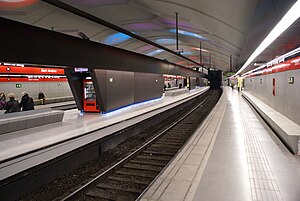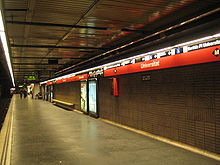Barcelona Metro line 1
This article may be expanded with text translated from the corresponding article in Catalan. (August 2019) Click [show] for important translation instructions.
|
| Barcelona Metro line 1 | |||||||||||||||||||||||||||||||||||||||||||||||||||||||||||||||||||||||||||||||||||||||||||||||||||||||||||||||||||||||||||||||||||||||||||||||||||||||||||||||||||||||||||||||||||||||||||||||||||||||||||||||||||||||||||||||||||||||||||||||||||||||||||||||||||||||||||||||||||||||||||||||||||||||||||||||||||||||||||||||||||||||||||||||||||||||||||||||||||||||||||||||||||||||||||
|---|---|---|---|---|---|---|---|---|---|---|---|---|---|---|---|---|---|---|---|---|---|---|---|---|---|---|---|---|---|---|---|---|---|---|---|---|---|---|---|---|---|---|---|---|---|---|---|---|---|---|---|---|---|---|---|---|---|---|---|---|---|---|---|---|---|---|---|---|---|---|---|---|---|---|---|---|---|---|---|---|---|---|---|---|---|---|---|---|---|---|---|---|---|---|---|---|---|---|---|---|---|---|---|---|---|---|---|---|---|---|---|---|---|---|---|---|---|---|---|---|---|---|---|---|---|---|---|---|---|---|---|---|---|---|---|---|---|---|---|---|---|---|---|---|---|---|---|---|---|---|---|---|---|---|---|---|---|---|---|---|---|---|---|---|---|---|---|---|---|---|---|---|---|---|---|---|---|---|---|---|---|---|---|---|---|---|---|---|---|---|---|---|---|---|---|---|---|---|---|---|---|---|---|---|---|---|---|---|---|---|---|---|---|---|---|---|---|---|---|---|---|---|---|---|---|---|---|---|---|---|---|---|---|---|---|---|---|---|---|---|---|---|---|---|---|---|---|---|---|---|---|---|---|---|---|---|---|---|---|---|---|---|---|---|---|---|---|---|---|---|---|---|---|---|---|---|---|---|---|---|---|---|---|---|---|---|---|---|---|---|---|---|---|---|---|---|---|---|---|---|---|---|---|---|---|---|---|---|---|---|---|---|---|---|---|---|---|---|---|---|---|---|---|---|---|---|---|---|---|---|---|---|---|---|---|---|---|---|---|---|---|---|---|---|---|---|---|---|---|---|---|---|---|---|---|---|---|---|---|---|---|---|---|---|---|---|---|---|---|---|---|---|---|---|---|---|---|---|---|
 | |||||||||||||||||||||||||||||||||||||||||||||||||||||||||||||||||||||||||||||||||||||||||||||||||||||||||||||||||||||||||||||||||||||||||||||||||||||||||||||||||||||||||||||||||||||||||||||||||||||||||||||||||||||||||||||||||||||||||||||||||||||||||||||||||||||||||||||||||||||||||||||||||||||||||||||||||||||||||||||||||||||||||||||||||||||||||||||||||||||||||||||||||||||||||||
 Sant Andreu station | |||||||||||||||||||||||||||||||||||||||||||||||||||||||||||||||||||||||||||||||||||||||||||||||||||||||||||||||||||||||||||||||||||||||||||||||||||||||||||||||||||||||||||||||||||||||||||||||||||||||||||||||||||||||||||||||||||||||||||||||||||||||||||||||||||||||||||||||||||||||||||||||||||||||||||||||||||||||||||||||||||||||||||||||||||||||||||||||||||||||||||||||||||||||||||
| Overview | |||||||||||||||||||||||||||||||||||||||||||||||||||||||||||||||||||||||||||||||||||||||||||||||||||||||||||||||||||||||||||||||||||||||||||||||||||||||||||||||||||||||||||||||||||||||||||||||||||||||||||||||||||||||||||||||||||||||||||||||||||||||||||||||||||||||||||||||||||||||||||||||||||||||||||||||||||||||||||||||||||||||||||||||||||||||||||||||||||||||||||||||||||||||||||
| Service type | Conventional metro[1] | ||||||||||||||||||||||||||||||||||||||||||||||||||||||||||||||||||||||||||||||||||||||||||||||||||||||||||||||||||||||||||||||||||||||||||||||||||||||||||||||||||||||||||||||||||||||||||||||||||||||||||||||||||||||||||||||||||||||||||||||||||||||||||||||||||||||||||||||||||||||||||||||||||||||||||||||||||||||||||||||||||||||||||||||||||||||||||||||||||||||||||||||||||||||||||
| System | Barcelona Metro | ||||||||||||||||||||||||||||||||||||||||||||||||||||||||||||||||||||||||||||||||||||||||||||||||||||||||||||||||||||||||||||||||||||||||||||||||||||||||||||||||||||||||||||||||||||||||||||||||||||||||||||||||||||||||||||||||||||||||||||||||||||||||||||||||||||||||||||||||||||||||||||||||||||||||||||||||||||||||||||||||||||||||||||||||||||||||||||||||||||||||||||||||||||||||||
| Status | Operational | ||||||||||||||||||||||||||||||||||||||||||||||||||||||||||||||||||||||||||||||||||||||||||||||||||||||||||||||||||||||||||||||||||||||||||||||||||||||||||||||||||||||||||||||||||||||||||||||||||||||||||||||||||||||||||||||||||||||||||||||||||||||||||||||||||||||||||||||||||||||||||||||||||||||||||||||||||||||||||||||||||||||||||||||||||||||||||||||||||||||||||||||||||||||||||
| Locale | L'Hospitalet de Llobregat and Barcelona, Spain | ||||||||||||||||||||||||||||||||||||||||||||||||||||||||||||||||||||||||||||||||||||||||||||||||||||||||||||||||||||||||||||||||||||||||||||||||||||||||||||||||||||||||||||||||||||||||||||||||||||||||||||||||||||||||||||||||||||||||||||||||||||||||||||||||||||||||||||||||||||||||||||||||||||||||||||||||||||||||||||||||||||||||||||||||||||||||||||||||||||||||||||||||||||||||||
| First service | 1926 | ||||||||||||||||||||||||||||||||||||||||||||||||||||||||||||||||||||||||||||||||||||||||||||||||||||||||||||||||||||||||||||||||||||||||||||||||||||||||||||||||||||||||||||||||||||||||||||||||||||||||||||||||||||||||||||||||||||||||||||||||||||||||||||||||||||||||||||||||||||||||||||||||||||||||||||||||||||||||||||||||||||||||||||||||||||||||||||||||||||||||||||||||||||||||||
| Current operator(s) | TMB[1] | ||||||||||||||||||||||||||||||||||||||||||||||||||||||||||||||||||||||||||||||||||||||||||||||||||||||||||||||||||||||||||||||||||||||||||||||||||||||||||||||||||||||||||||||||||||||||||||||||||||||||||||||||||||||||||||||||||||||||||||||||||||||||||||||||||||||||||||||||||||||||||||||||||||||||||||||||||||||||||||||||||||||||||||||||||||||||||||||||||||||||||||||||||||||||||
| Route | |||||||||||||||||||||||||||||||||||||||||||||||||||||||||||||||||||||||||||||||||||||||||||||||||||||||||||||||||||||||||||||||||||||||||||||||||||||||||||||||||||||||||||||||||||||||||||||||||||||||||||||||||||||||||||||||||||||||||||||||||||||||||||||||||||||||||||||||||||||||||||||||||||||||||||||||||||||||||||||||||||||||||||||||||||||||||||||||||||||||||||||||||||||||||||
| Start | Hospital de Bellvitge | ||||||||||||||||||||||||||||||||||||||||||||||||||||||||||||||||||||||||||||||||||||||||||||||||||||||||||||||||||||||||||||||||||||||||||||||||||||||||||||||||||||||||||||||||||||||||||||||||||||||||||||||||||||||||||||||||||||||||||||||||||||||||||||||||||||||||||||||||||||||||||||||||||||||||||||||||||||||||||||||||||||||||||||||||||||||||||||||||||||||||||||||||||||||||||
| Stops | 30[1] | ||||||||||||||||||||||||||||||||||||||||||||||||||||||||||||||||||||||||||||||||||||||||||||||||||||||||||||||||||||||||||||||||||||||||||||||||||||||||||||||||||||||||||||||||||||||||||||||||||||||||||||||||||||||||||||||||||||||||||||||||||||||||||||||||||||||||||||||||||||||||||||||||||||||||||||||||||||||||||||||||||||||||||||||||||||||||||||||||||||||||||||||||||||||||||
| End | Fondo | ||||||||||||||||||||||||||||||||||||||||||||||||||||||||||||||||||||||||||||||||||||||||||||||||||||||||||||||||||||||||||||||||||||||||||||||||||||||||||||||||||||||||||||||||||||||||||||||||||||||||||||||||||||||||||||||||||||||||||||||||||||||||||||||||||||||||||||||||||||||||||||||||||||||||||||||||||||||||||||||||||||||||||||||||||||||||||||||||||||||||||||||||||||||||||
| Distance travelled | 20.7 km (12.9 mi)[1] | ||||||||||||||||||||||||||||||||||||||||||||||||||||||||||||||||||||||||||||||||||||||||||||||||||||||||||||||||||||||||||||||||||||||||||||||||||||||||||||||||||||||||||||||||||||||||||||||||||||||||||||||||||||||||||||||||||||||||||||||||||||||||||||||||||||||||||||||||||||||||||||||||||||||||||||||||||||||||||||||||||||||||||||||||||||||||||||||||||||||||||||||||||||||||||
| Average journey time | 35 minutes[1] | ||||||||||||||||||||||||||||||||||||||||||||||||||||||||||||||||||||||||||||||||||||||||||||||||||||||||||||||||||||||||||||||||||||||||||||||||||||||||||||||||||||||||||||||||||||||||||||||||||||||||||||||||||||||||||||||||||||||||||||||||||||||||||||||||||||||||||||||||||||||||||||||||||||||||||||||||||||||||||||||||||||||||||||||||||||||||||||||||||||||||||||||||||||||||||
| Technical | |||||||||||||||||||||||||||||||||||||||||||||||||||||||||||||||||||||||||||||||||||||||||||||||||||||||||||||||||||||||||||||||||||||||||||||||||||||||||||||||||||||||||||||||||||||||||||||||||||||||||||||||||||||||||||||||||||||||||||||||||||||||||||||||||||||||||||||||||||||||||||||||||||||||||||||||||||||||||||||||||||||||||||||||||||||||||||||||||||||||||||||||||||||||||||
| Rolling stock | 4000 and 6000 series[1] | ||||||||||||||||||||||||||||||||||||||||||||||||||||||||||||||||||||||||||||||||||||||||||||||||||||||||||||||||||||||||||||||||||||||||||||||||||||||||||||||||||||||||||||||||||||||||||||||||||||||||||||||||||||||||||||||||||||||||||||||||||||||||||||||||||||||||||||||||||||||||||||||||||||||||||||||||||||||||||||||||||||||||||||||||||||||||||||||||||||||||||||||||||||||||||
| Track gauge | 1,672 mm (5 ft 5+13⁄16 in)[1] | ||||||||||||||||||||||||||||||||||||||||||||||||||||||||||||||||||||||||||||||||||||||||||||||||||||||||||||||||||||||||||||||||||||||||||||||||||||||||||||||||||||||||||||||||||||||||||||||||||||||||||||||||||||||||||||||||||||||||||||||||||||||||||||||||||||||||||||||||||||||||||||||||||||||||||||||||||||||||||||||||||||||||||||||||||||||||||||||||||||||||||||||||||||||||||
| Electrification | Rigid overhead wire[1] | ||||||||||||||||||||||||||||||||||||||||||||||||||||||||||||||||||||||||||||||||||||||||||||||||||||||||||||||||||||||||||||||||||||||||||||||||||||||||||||||||||||||||||||||||||||||||||||||||||||||||||||||||||||||||||||||||||||||||||||||||||||||||||||||||||||||||||||||||||||||||||||||||||||||||||||||||||||||||||||||||||||||||||||||||||||||||||||||||||||||||||||||||||||||||||
| Track owner(s) | TMB | ||||||||||||||||||||||||||||||||||||||||||||||||||||||||||||||||||||||||||||||||||||||||||||||||||||||||||||||||||||||||||||||||||||||||||||||||||||||||||||||||||||||||||||||||||||||||||||||||||||||||||||||||||||||||||||||||||||||||||||||||||||||||||||||||||||||||||||||||||||||||||||||||||||||||||||||||||||||||||||||||||||||||||||||||||||||||||||||||||||||||||||||||||||||||||
| |||||||||||||||||||||||||||||||||||||||||||||||||||||||||||||||||||||||||||||||||||||||||||||||||||||||||||||||||||||||||||||||||||||||||||||||||||||||||||||||||||||||||||||||||||||||||||||||||||||||||||||||||||||||||||||||||||||||||||||||||||||||||||||||||||||||||||||||||||||||||||||||||||||||||||||||||||||||||||||||||||||||||||||||||||||||||||||||||||||||||||||||||||||||||||
Line 1, shortened to L1, coloured red and often simply called Línia vermella ("Red Line"), is the second oldest Barcelona Metro line, after line L3. It is the longest line of the Barcelona Metro, and links L'Hospitalet de Llobregat and Santa Coloma de Gramenet. Originally operated by the independent Ferrocarril Metropolitano Transversal de Barcelona, it is today operated by Transports Metropolitans de Barcelona (TMB) and is part of the ATM fare-integrated main transport system. L1 is the only metro line in Spain to use Iberian gauge tracks, as used by most Spanish main line railways.[1]
The line was created in 1926 as a means to join the rail stations the city had in the 1920s, and in preparation for the 1929 Universal Exposition. It has been growing since then to become, as of 2007, a large line made up of 30 stations, the network's busiest. These stations are architecturally homogenous, and as in the case of most metro lines in Barcelona, ornamentation is virtually absent from them. Some of them are improving their artificial lighting. Most of the line is underground, except for one short section, and at one point it shares tunnels with mainline tracks.[1]
Future plans are for the line to be extended southbound into El Prat de Llobregat and from its north terminus into Badalona, where it will join L2 in Badalona Centre.[1][2]
History[]

- 1926 – Bordeta-Catalunya section opened.
- 1932 – Bordeta-Santa Eulàlia and Catalunya-Arc de Triomf sections opened.
- 1933 – Arc de Triomf-Marina section opened.
- 1951 – Marina-Clot section opened.
- 1952 – Clot-Navas section opened.
- 1954 – Navas-Fabra i Puig section opened.
- 1968 – Fabra i Puig-Torras i Bages section opened.
- 1983 – Torras i Bages-Santa Coloma and Santa Eulàlia-Torrassa sections opened. Bordeta station closed.
- 1987 – Torrassa-Avinguda Carrilet section opened.
- 1989 – Avinguda Carrilet-Feixa Llarga (now Hospital de Bellvitge) section opened.
- 1992 – Santa Coloma-Fondo section opened.
Route[]

The line runs from Hospital de Bellvitge, in the municipality of L'Hospitalet de Llobregat, and Fondo, in Santa Coloma de Gramenet. Most of the line is underground, except for a short section between Plaça de Sants and Santa Eulàlia stations.[2]
Between Catalunya and Arc de Triomf stations, L1 shares tunnels with an ADIF owned main line railway, carrying RENFE operated Rodalies de Catalunya suburban passenger services. With four tracks in the tunnels, the outer tracks carry L1 metro services whilst the middle two tracks carry main line services. At Catalunya station, the L1 metro trains stop at side platforms, whilst the Rodalies de Catalunya trains serve an island platform. At Arc de Triomf station, the Rodalies de Catalunya trains stop at side platforms, whilst the L1 trains serve platforms in flanking single track tunnels. At the intermediate Urquinaona station, the L1 metro trains stop at side platforms, whilst main line trains do not stop.[2]
Stations[]
The line serves the following stations:[2]
| Location | Station | Opened | Connections |
|---|---|---|---|
| L'Hospitalet de Llobregat | Hospital de Bellvitge |
1989 | |
| Bellvitge |
1989 | ||
| Avinguda Carrilet |
1987 | FGC: L8, S33, S4, S8, R5, R50, R6, R60 | |
| Rambla Just Oliveras |
1987 | Rodalies de Catalunya: R1, R3, R4, , RG1 | |
| Can Serra |
1987 | ||
| Florida |
1987 | ||
| Torrassa |
1983 | Barcelona Metro: L9, L10 | |
| Santa Eulàlia |
1932 | ||
| Sants-Montjuïc, Barcelona | Mercat Nou |
1926 | |
| Plaça de Sants |
1926 | Barcelona Metro: L5 | |
| Hostafrancs |
1926 | ||
| Plaça d'Espanya | 1926 | FGC: L8, S33, S4, S8, R5, R50, R6, R60 Barcelona Metro: L3 | |
| Eixample, Barcelona | Rocafort |
1926 | |
| Urgell |
1926 | ||
| Universitat |
1926 | Barcelona Metro: L2 | |
| Plaça de Catalunya |
1926 | Renfe Media Distancia: Rodalies de Catalunya: R1, R3, R4, RG1 FGC: L6, L7, S1, S2, S5, S55 Barcelona Metro: L3 | |
| Urquinaona |
1926 | ||
| Arc de Triomf |
1932 | Rodalies de Catalunya: R1, R3, R4, RG1, Barcelona Metro: L4 | |
| Sant Martí, Barcelona | Marina |
1933 | Trambesòs: T4 |
| Glòries |
1951 | Trambesòs: T4 | |
| Clot |
1951 | Renfe Media Distancia: R11 (at El Clot-Aragó) Rodalies de Catalunya: R1, R2, R2 Nord, RG1 (at El Clot-Aragó) Barcelona Metro: L2 | |
| Sant Andreu, Barcelona | Navas |
1953 | |
| La Sagrera-Meridiana |
1954 | Renfe Media Distancia: Rodalies de Catalunya: R3, R4 Barcelona Metro: L5, L9, L10 | |
| Fabra i Puig |
1954 | Renfe Media Distancia: (at Sant Andreu Arenal) Rodalies de Catalunya: R3, R4, R7 (at Sant Andreu Arenal) | |
| Sant Andreu |
1968 | Renfe Media Distancia: R11 (at Sant Andreu Comtal) Rodalies de Catalunya: R2, R2 Nord (at Sant Andreu Comtal) | |
| Torras i Bages |
1968 | ||
| Trinitat Vella | 1983 | ||
| Baró de Viver |
1983 | ||
| Santa Coloma de Gramenet | Santa Coloma |
1983 | |
| Fondo |
1992 | Barcelona Metro: L9 |
References[]
External links[]
- Official website
 Geographic data related to Barcelona Metro line 1 at OpenStreetMap
Geographic data related to Barcelona Metro line 1 at OpenStreetMap- Stations and links of this line from OpenStreetMap data
- Trenscat.com
- Barcelona Metro lines
- Railway lines opened in 1926
- 1672 mm gauge railways in Spain
- Transport in Ciutat Vella
- Transport in Eixample
- Transport in Sant Andreu
- Transport in Sant Martí (district)
- Transport in Sants-Montjuïc
- Transport in L'Hospitalet de Llobregat
